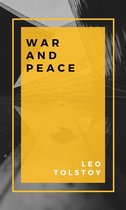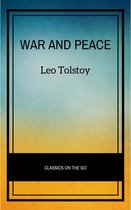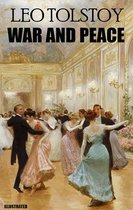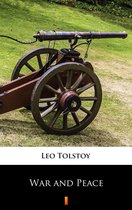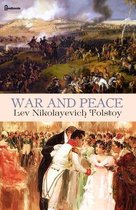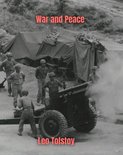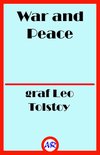War and Peace Ebook Tooltip Ebooks kunnen worden gelezen op uw computer en op daarvoor geschikte e-readers.
Afbeeldingen
Artikel vergelijken
Auteur:
Graf Leo Tolstoy
- Engels
- E-book
- 1230003821510
- 15 april 2020
- Epub zonder kopieerbeveiliging (DRM)
Samenvatting
Leo Tolstoy's War and Peace, considered one of the finest novels ever written, chronicles Napoleon's invasion of Russia during the early 19th century. A linked table of contents is included to navigate this massive epic.
"War and Peace" is not just a classic novel, but a real heroic epic, the literary value of which is not comparable to any other work. The writer himself considered it a poem, where the private life of a person is inseparable from the history of the whole country. Events and impressions from a peaceful life do not leave characters during the war, on the contrary, they come to life more strongly in their souls. War for them is a test of the importance and significance of man. The bearers of true heroism in Tolstoy's novel were ordinary people.
War and Peace is a novel by the Russian author Leo Tolstoy, published serially, then in its entirety in 1869. It is regarded as one of Tolstoy's finest literary achievements.
The novel chronicles the French invasion of Russia and the impact of the Napoleonic era on Tsarist society through the stories of five Russian aristocratic families. Portions of an earlier version, titled The Year 1805, were serialized in The Russian Messenger from 1865 to 1867, then published in its entirety in 1869.
Tolstoy said War and Peace is ''not a novel, even less is it a poem, and still less a historical chronicle.'' Large sections, especially the later chapters, are philosophical discussion rather than narrative. Tolstoy also said that the best Russian literature does not conform to standards and hence hesitated to call War and Peace a novel. Instead, he regarded Anna Karenina as his first true novel.
Tolstoy began writing War and Peace in 1863, the year that he finally married and settled down at his country estate. The first half of the book was written under the name ''1805''. During the writing of the second half, he read widely and acknowledged Schopenhauer as one of his main inspirations. Tolstoy wrote in a letter to Afanasy Fet that what he has written in War and Peace is also said by Schopenhauer in The World as Will and Representation. However, Tolstoy approaches ''it from the other side.''
The first draft of the novel was completed in 1863. In 1865, the periodical Russkiy Vestnik (The Russian Messenger) published the first part of this draft under the title 1805 and published more the following year. Tolstoy was dissatisfied with this version, although he allowed several parts of it to be published with a different ending in 1867. He heavily rewrote the entire novel between 1866 and 1869. Tolstoy's wife, Sophia Tolstaya, copied as many as seven separate complete manuscripts before Tolstoy considered it again ready for publication. The version that was published in Russkiy Vestnik had a very different ending from the version eventually published under the title War and Peace in 1869. Russians who had read the serialized version were eager to buy the complete novel, and it sold out almost immediately. The novel was translated almost immediately after publication into many other languages.
It is unknown why Tolstoy changed the name to War and Peace. He may have borrowed the title from the 1861 work of Pierre-Joseph Proudhon: La Guerre et la Paix (''War and Peace'' in French). The title may also be another reference to Titus, described as being a master of ''war and peace'' in The Twelve Caesars, written by Suetonius in 119. The completed novel was then called Voyna i mir (Война и мир in new-style orthography; in English War and Peace).
The 1805 manuscript was re-edited and annotated in Russia in 1893 and since has been translated into English, German, French, Spanish, Dutch, Swedish, Finnish, Albanian, Korean, and Czech.
Tolstoy was instrumental in bringing a new kind of consciousness to the novel. His narrative structure is noted for its god's eye point of view over and within events, but also in the way it swiftly and seamlessly portrayed a particular character's point of view. His use of visual detail is often comparable to cinema, using literary techniques that resemble panning, wide shots and close-ups. These devices, while not exclusive to Tolstoy, are part of the new style of the novel that arose in the mid-19th century and of which Tolstoy proved himself a master.
The standard Russian text of War and Peace is divided into four books (comprising fifteen parts) and an epilogue in two parts. Roughly the first half is concerned strictly with the fictional characters, whereas the latter parts, as well as the second part of the epilogue, increasingly consist of essays about the nature of war, power, history, and historiography. Tolstoy interspersed these essays into the story in a way that defies previous fictional convention. Certain abridged versions remove these essays entirely, while others, published even during Tolstoy's life, simply moved these essays into an appendix. Source: Wikipedia
About Author: Count Lev Nikolayevich Tolstoy (/ˈtoʊlstɔɪ, ˈtɒl-/; Russian: Лев Николаевич Толстой, tr. Lev Nikoláyevich Tolstoy; [lʲef nʲɪkɐˈlaɪvʲɪtɕ tɐlˈstoj] (About this soundlisten); 9 September [O.S. 28 August] 1828 – 20 November [O.S. 7 November] 1910), usually referred to in English as Leo Tolstoy, was a Russian writer who is regarded as one of the greatest authors of all time. He received multiple nominations for the Nobel Prize in Literature every year from 1902 to 1906, and nominations for Nobel Peace Prize in 1901, 1902 and 1910, and the fact that he never won is a major Nobel prize controversy.
Born to an aristocratic Russian family in 1828, he is best known for the novels War and Peace (1869) and Anna Karenina (1877),[8] often cited as pinnacles of realist fiction. He first achieved literary acclaim in his twenties with his semi-autobiographical trilogy, Childhood, Boyhood, and Youth (1852–1856), and Sevastopol Sketches (1855), based upon his experiences in the Crimean War. Tolstoy's fiction includes dozens of short stories and several novellas such as The Death of Ivan Ilyich (1886), Family Happiness (1859), and Hadji Murad (1912). He also wrote plays and numerous philosophical essays.
In the 1870s Tolstoy experienced a profound moral crisis, followed by what he regarded as an equally profound spiritual awakening, as outlined in his non-fiction work A Confession (1882). His literal interpretation of the ethical teachings of Jesus, centering on the Sermon on the Mount, caused him to become a fervent Christian anarchist and pacifist. Tolstoy's ideas on nonviolent resistance, expressed in such works as The Kingdom of God Is Within You (1894), had a profound impact on such pivotal 20th-century figures as Mahatma Gandhi and Martin Luther King Jr. Tolstoy also became a dedicated advocate of Georgism, the economic philosophy of Henry George, which he incorporated into his writing, particularly Resurrection (1899).
The Tolstoys were a well-known family of old Russian nobility who traced their ancestry to a mythical nobleman named Indris described by Pyotr Tolstoy as arriving ''from Nemec, from the lands of Caesar'' to Chernigov in 1353 along with his two sons Litvinos (or Litvonis) and Zimonten (or Zigmont) and a druzhina of 3000 people. While the word ''Nemec'' has been long used to describe Germans only, at that time it was applied to any foreigner who didn't speak Russian (from the word nemoy meaning mute). Indris was then converted to Eastern Orthodoxy, under the name of Leonty, and his sons as Konstantin and Feodor. Konstantin's grandson Andrei Kharitonovich was nicknamed Tolstiy (translated as fat) by Vasily II of Moscow after he moved from Chernigov to Moscow.
Because of the pagan names and the fact that Chernigov at the time was ruled by Demetrius I Starshy some researchers concluded that they were Lithuanians who arrived from the Grand Duchy of Lithuania. At the same time, no mention of Indris was ever found in the 14th – 16th-century documents, while the Chernigov Chronicles used by Pyotr Tolstoy as a reference were lost. The first documented members of the Tolstoy family also lived during the 17th century, thus Pyotr Tolstoy himself is generally considered the founder of the noble house, being granted the title of count by Peter the Great.
The Tolstoys were a well-known family of old Russian nobility who traced their ancestry to a mythical nobleman named Indris described by Pyotr Tolstoy as arriving ''from Nemec, from the lands of Caesar'' to Chernigov in 1353 along with his two sons Litvinos (or Litvonis) and Zimonten (or Zigmont) and a druzhina of 3000 people. While the word ''Nemec'' has been long used to describe Germans only, at that time it was applied to any foreigner who didn't speak Russian (from the word nemoy meaning mute). Indris was then converted to Eastern Orthodoxy, under the name of Leonty, and his sons as Konstantin and Feodor. Konstantin's grandson Andrei Kharitonovich was nicknamed Tolstiy (translated as fat) by Vasily II of Moscow after he moved from Chernigov to Moscow.
Because of the pagan names and the fact that Chernigov at the time was ruled by Demetrius I Starshy some researchers concluded that they were Lithuanians who arrived from the Grand Duchy of Lithuania. At the same time, no mention of Indris was ever found in the 14th – 16th-century documents, while the Chernigov Chronicles used by Pyotr Tolstoy as a reference were lost. The first documented members of the Tolstoy family also lived during the 17th century, thus P
"War and Peace" is not just a classic novel, but a real heroic epic, the literary value of which is not comparable to any other work. The writer himself considered it a poem, where the private life of a person is inseparable from the history of the whole country. Events and impressions from a peaceful life do not leave characters during the war, on the contrary, they come to life more strongly in their souls. War for them is a test of the importance and significance of man. The bearers of true heroism in Tolstoy's novel were ordinary people.
War and Peace is a novel by the Russian author Leo Tolstoy, published serially, then in its entirety in 1869. It is regarded as one of Tolstoy's finest literary achievements.
The novel chronicles the French invasion of Russia and the impact of the Napoleonic era on Tsarist society through the stories of five Russian aristocratic families. Portions of an earlier version, titled The Year 1805, were serialized in The Russian Messenger from 1865 to 1867, then published in its entirety in 1869.
Tolstoy said War and Peace is ''not a novel, even less is it a poem, and still less a historical chronicle.'' Large sections, especially the later chapters, are philosophical discussion rather than narrative. Tolstoy also said that the best Russian literature does not conform to standards and hence hesitated to call War and Peace a novel. Instead, he regarded Anna Karenina as his first true novel.
Tolstoy began writing War and Peace in 1863, the year that he finally married and settled down at his country estate. The first half of the book was written under the name ''1805''. During the writing of the second half, he read widely and acknowledged Schopenhauer as one of his main inspirations. Tolstoy wrote in a letter to Afanasy Fet that what he has written in War and Peace is also said by Schopenhauer in The World as Will and Representation. However, Tolstoy approaches ''it from the other side.''
The first draft of the novel was completed in 1863. In 1865, the periodical Russkiy Vestnik (The Russian Messenger) published the first part of this draft under the title 1805 and published more the following year. Tolstoy was dissatisfied with this version, although he allowed several parts of it to be published with a different ending in 1867. He heavily rewrote the entire novel between 1866 and 1869. Tolstoy's wife, Sophia Tolstaya, copied as many as seven separate complete manuscripts before Tolstoy considered it again ready for publication. The version that was published in Russkiy Vestnik had a very different ending from the version eventually published under the title War and Peace in 1869. Russians who had read the serialized version were eager to buy the complete novel, and it sold out almost immediately. The novel was translated almost immediately after publication into many other languages.
It is unknown why Tolstoy changed the name to War and Peace. He may have borrowed the title from the 1861 work of Pierre-Joseph Proudhon: La Guerre et la Paix (''War and Peace'' in French). The title may also be another reference to Titus, described as being a master of ''war and peace'' in The Twelve Caesars, written by Suetonius in 119. The completed novel was then called Voyna i mir (Война и мир in new-style orthography; in English War and Peace).
The 1805 manuscript was re-edited and annotated in Russia in 1893 and since has been translated into English, German, French, Spanish, Dutch, Swedish, Finnish, Albanian, Korean, and Czech.
Tolstoy was instrumental in bringing a new kind of consciousness to the novel. His narrative structure is noted for its god's eye point of view over and within events, but also in the way it swiftly and seamlessly portrayed a particular character's point of view. His use of visual detail is often comparable to cinema, using literary techniques that resemble panning, wide shots and close-ups. These devices, while not exclusive to Tolstoy, are part of the new style of the novel that arose in the mid-19th century and of which Tolstoy proved himself a master.
The standard Russian text of War and Peace is divided into four books (comprising fifteen parts) and an epilogue in two parts. Roughly the first half is concerned strictly with the fictional characters, whereas the latter parts, as well as the second part of the epilogue, increasingly consist of essays about the nature of war, power, history, and historiography. Tolstoy interspersed these essays into the story in a way that defies previous fictional convention. Certain abridged versions remove these essays entirely, while others, published even during Tolstoy's life, simply moved these essays into an appendix. Source: Wikipedia
About Author: Count Lev Nikolayevich Tolstoy (/ˈtoʊlstɔɪ, ˈtɒl-/; Russian: Лев Николаевич Толстой, tr. Lev Nikoláyevich Tolstoy; [lʲef nʲɪkɐˈlaɪvʲɪtɕ tɐlˈstoj] (About this soundlisten); 9 September [O.S. 28 August] 1828 – 20 November [O.S. 7 November] 1910), usually referred to in English as Leo Tolstoy, was a Russian writer who is regarded as one of the greatest authors of all time. He received multiple nominations for the Nobel Prize in Literature every year from 1902 to 1906, and nominations for Nobel Peace Prize in 1901, 1902 and 1910, and the fact that he never won is a major Nobel prize controversy.
Born to an aristocratic Russian family in 1828, he is best known for the novels War and Peace (1869) and Anna Karenina (1877),[8] often cited as pinnacles of realist fiction. He first achieved literary acclaim in his twenties with his semi-autobiographical trilogy, Childhood, Boyhood, and Youth (1852–1856), and Sevastopol Sketches (1855), based upon his experiences in the Crimean War. Tolstoy's fiction includes dozens of short stories and several novellas such as The Death of Ivan Ilyich (1886), Family Happiness (1859), and Hadji Murad (1912). He also wrote plays and numerous philosophical essays.
In the 1870s Tolstoy experienced a profound moral crisis, followed by what he regarded as an equally profound spiritual awakening, as outlined in his non-fiction work A Confession (1882). His literal interpretation of the ethical teachings of Jesus, centering on the Sermon on the Mount, caused him to become a fervent Christian anarchist and pacifist. Tolstoy's ideas on nonviolent resistance, expressed in such works as The Kingdom of God Is Within You (1894), had a profound impact on such pivotal 20th-century figures as Mahatma Gandhi and Martin Luther King Jr. Tolstoy also became a dedicated advocate of Georgism, the economic philosophy of Henry George, which he incorporated into his writing, particularly Resurrection (1899).
The Tolstoys were a well-known family of old Russian nobility who traced their ancestry to a mythical nobleman named Indris described by Pyotr Tolstoy as arriving ''from Nemec, from the lands of Caesar'' to Chernigov in 1353 along with his two sons Litvinos (or Litvonis) and Zimonten (or Zigmont) and a druzhina of 3000 people. While the word ''Nemec'' has been long used to describe Germans only, at that time it was applied to any foreigner who didn't speak Russian (from the word nemoy meaning mute). Indris was then converted to Eastern Orthodoxy, under the name of Leonty, and his sons as Konstantin and Feodor. Konstantin's grandson Andrei Kharitonovich was nicknamed Tolstiy (translated as fat) by Vasily II of Moscow after he moved from Chernigov to Moscow.
Because of the pagan names and the fact that Chernigov at the time was ruled by Demetrius I Starshy some researchers concluded that they were Lithuanians who arrived from the Grand Duchy of Lithuania. At the same time, no mention of Indris was ever found in the 14th – 16th-century documents, while the Chernigov Chronicles used by Pyotr Tolstoy as a reference were lost. The first documented members of the Tolstoy family also lived during the 17th century, thus Pyotr Tolstoy himself is generally considered the founder of the noble house, being granted the title of count by Peter the Great.
The Tolstoys were a well-known family of old Russian nobility who traced their ancestry to a mythical nobleman named Indris described by Pyotr Tolstoy as arriving ''from Nemec, from the lands of Caesar'' to Chernigov in 1353 along with his two sons Litvinos (or Litvonis) and Zimonten (or Zigmont) and a druzhina of 3000 people. While the word ''Nemec'' has been long used to describe Germans only, at that time it was applied to any foreigner who didn't speak Russian (from the word nemoy meaning mute). Indris was then converted to Eastern Orthodoxy, under the name of Leonty, and his sons as Konstantin and Feodor. Konstantin's grandson Andrei Kharitonovich was nicknamed Tolstiy (translated as fat) by Vasily II of Moscow after he moved from Chernigov to Moscow.
Because of the pagan names and the fact that Chernigov at the time was ruled by Demetrius I Starshy some researchers concluded that they were Lithuanians who arrived from the Grand Duchy of Lithuania. At the same time, no mention of Indris was ever found in the 14th – 16th-century documents, while the Chernigov Chronicles used by Pyotr Tolstoy as a reference were lost. The first documented members of the Tolstoy family also lived during the 17th century, thus P
Productspecificaties
Wij vonden geen specificaties voor jouw zoekopdracht '{SEARCH}'.
Inhoud
- Taal
- en
- Bindwijze
- E-book
- Oorspronkelijke releasedatum
- 15 april 2020
- Ebook Formaat
- Epub zonder kopieerbeveiliging (DRM)
- Illustraties
- Nee
Betrokkenen
- Hoofdauteur
- Graf Leo Tolstoy
- Hoofduitgeverij
- Sanjiv Makkar
Vertaling
- Eerste Vertaler
- Louise Maude
- Tweede Vertaler
- Aylmer Maude
Lees mogelijkheden
- Lees dit ebook op
- Android (smartphone en tablet) | Kobo e-reader | Desktop (Mac en Windows) | iOS (smartphone en tablet) | Windows (smartphone en tablet)
Overige kenmerken
- Studieboek
- Nee
EAN
- EAN
- 1230003821510
Je vindt dit artikel in
Kies gewenste uitvoering
Bindwijze
: E-book
Bekijk alle bindwijzen (5)
Prijsinformatie en bestellen
De prijs van dit product is 4 euro en 90 cent.
Direct beschikbaar
Verkoop door bol
- E-book is direct beschikbaar na aankoop
- E-books lezen is voordelig
- Dag en nacht klantenservice
- Veilig betalen
Houd er rekening mee dat je downloadartikelen niet kunt annuleren of retourneren. Bij nog niet verschenen producten kun je tot de verschijningsdatum annuleren.
Zie ook de retourvoorwaarden
Alle bindwijzen en edities (5)
Rapporteer dit artikel
Je wilt melding doen van illegale inhoud over dit artikel:
- Ik wil melding doen als klant
- Ik wil melding doen als autoriteit of trusted flagger
- Ik wil melding doen als partner
- Ik wil melding doen als merkhouder
Geen klant, autoriteit, trusted flagger, merkhouder of partner? Gebruik dan onderstaande link om melding te doen.
